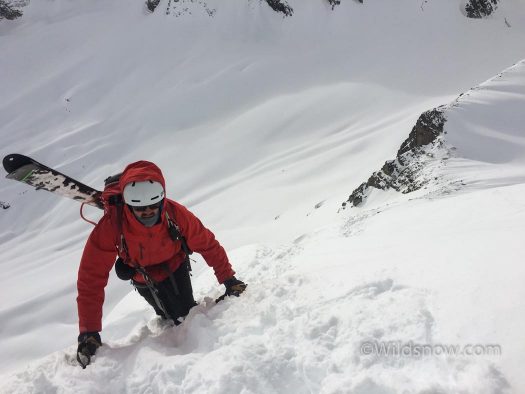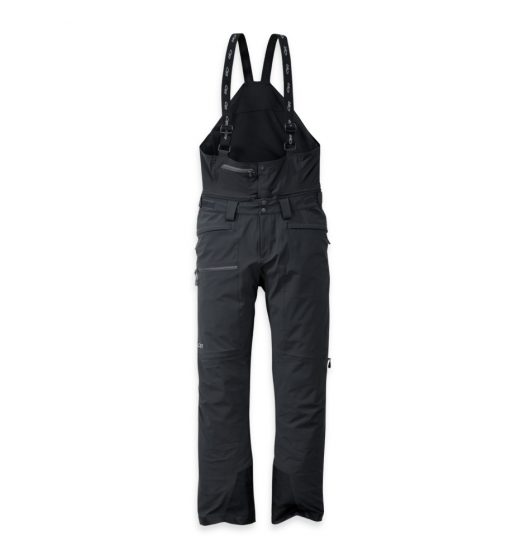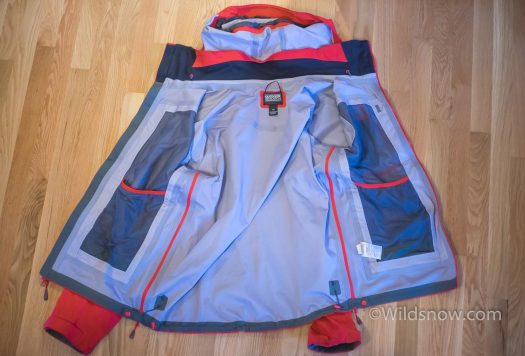When I lived in Colorado, I skied almost exclusively in softshell pants and jacket, only using Gore-Tex® during the nastiest storm days, or as an emergency layer buried in my pack (mostly in the spring). I tried that when I moved to the wet and scrappy Pacific Northwest, but it didn’t work so well. The results were somewhat similar to sailing around Cape Horn in a T-shirt. I soon ditched softshell for Gore-Tex®, and haven’t looked back. Nowadays the only time you’ll see me in softshell gear is in the springtime, or during our semi-annual “Juneuary” midwinter high pressure events. Or when I’m back in sunny Colorado.
Hardshell clothes work fairly well at keeping you dry, but the breathability of such still leaves a lot to be desired. I usually remove my shell while skinning, and leg vents are my friends. Outdoor Research’s new AscentShell™ fabric aims to be a “waterproof” softshell fabric, that has the waterproofness of a hardshell, while increasing breathability. Their claims piqued my interest, and I tried it out this winter.
Skyward jacket and pants are the flagship pieces for OR’s AscentShell™ fabric. At first glance, the gear looks like a pair of waterproof bibs and a storm shell. The fabric is fairly thin, feels much more like a stretchy hard-shell material than a softshell. This is good, since another disadvantage with traditional softshells is the fabric’s weight and bulk compared to a hardshell.
Skyward pants are a “convertible” bib pant: standard ski pant with a zip-off breathable bib piece that attaches around the waist. They have two long zippered side vents, and detachable powder gaiters.
The pants have a variety of pockets, including two hip pockets, one right hand front thigh pocket, one left hand rear-thigh pocket, a right hand rear pocket, and a small front pocket on the removable bib portion. In the right hand hip pocket there’s an interior mesh beacon pocket, with a carabiner clip for the lanyard (like many of OR’s pants). That might be a bit much in the pocket department, but most are appreciated.
Another notable feature is that the powder gaiters have a little slot in the side through which a boot’s power strap can be routed, so you don’t have to move the gaiter to adjust the power strap. Nice touch. I have the pants in size medium, and they fit my 5 foot 10 inch frame well.
Skyward Jacket
The jacket has two hip pockets, two chest pockets and two interior drop-in pockets (once you use them, you’ll be addicted). All pockets open into an interior mesh surface, allowing them to do double duty as vents. OR’s signature full-length pit-zips extend all the way to the hem of the jacket. While the jacket has a permanent hood, it also has a full collar that separates the neck from the hood, useful for keeping snow and water from draining down the back of your neck. The Skyward would be simpler and slightly lighter without the hip pockets, which are somewhat useless when you’re wearing a backpack — though they do come in handy at trailheads and coffee bars.
I ordered the jacket in a size large, so it would comfortably fit over layers. It fits well, albeit a little baggy. If you’re looking for a more trim look and you’re my size (5’10’’, 150 lbs) then size down to medium.
The Pacific Northwest is wet, and 2016/2017 was no exception. I’ve been using the Skyward jacket and pants all season, and got a really good feel for how they perform in a variety of weather conditions. I used them both in the backcountry and on the ski area, in everything from sunshine to torrential downpours.
There were two occasions where the fabric seemed to fail, and my inner layers got wet. One was standing around for five hours in the rain during an avalanche class, and the other was skiing Jackson Hole Resort in a torrential thunderstorm; two of the wettest ski experiences I’ve had in awhile.
In both instances the crotch area of the pants leaked a bit and my long underwear got wet. Despite what my long underwear looked like, I promise I didn’t have an “accident.” Interestingly the fabric was perfectly waterproof elsewhere on the jacket and the pants.
The issue could have been the result of the non-waterproof front zip on the pants. Or, perhaps just that that area gets the full brunt of the weather, while also being crunched and creased by leg movement, which is enough to force water through the fabric. Regardless, it shows the pants aren’t quite equivalent to a pair of full bore Gore-Tex® bibs. (Though during those wet events, some of the folks in hardshell gear did get wet, so perhaps I’m being too demanding?)
I wore the Skyward pants in a variety of lighter rain storms and heavy wet snow storms, and stayed dry. The AscentShell™ fabric is certainly an order of magnitude more waterproof than any softshell fabric I have seen. I wouldn’t even consider using anything other than a hardshell throughout most of the PNW winter. However, the AscentShell™ fabric does the trick just fine.
In the future, I’ll continue using the Skyward jacket and pants in nearly all weather conditions, with the exception of when the forecast calls for exceptionally heavy rain. When that happens I’ll be on the couch, or if I’m forced outside into the deluge, I’ll be in wall-to-wall Gore-Tex®.
Shop for Outdoor Research ski clothing here.
Louie Dawson earned his Bachelor Degree in Industrial Design from Western Washington University in 2014. When he’s not skiing Mount Baker or somewhere equally as snowy, he’s thinking about new products to make ski mountaineering more fun and safe.




